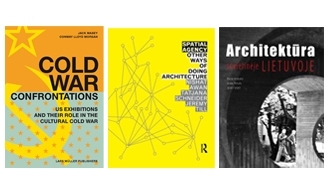Ieva Zībārte, Ingrid Ruudi, Marija Drėmaitė - CRITICAL PRACTICES IN ARCHITECTURE OF THE BALTIC REGION
DISSIDENCE THROUGH ARCHITECTURE
The Conversation is chaired by
LOLITA JABLONSKIENĖ
The concluding fifth conversation will explore critical practices within the Baltic region.
Speakers invited from Lithuania, Latvia and Estonia will elaborate on different forms of critical practices in architecture that formed a response to the 'stifling' standardised language of Soviet architecture.
Ieva Zibarte will present her investigations, discoveries and stories of Post-war modernism in Latvia, her work tracing the Latvian and Baltic architects connections with the West will uncover how this uncensored admiration reconfigured the architectural context within the region.
Marija Dremaite will explore the questions: In what form the critical practices could exist in the society with no right of free expression? How visible it was and what was the outcome? Did architects critically targeted the boundaries of architecture or was it a general critique directed at the ideology and political issues of the Soviet State?
Ingrid Ruudi will give one possible insight into Estonian architecture and art scene during the perestroika period. What kind of critical position would be possible in the turmoil between the falling of the Soviet regime and the rising hopes for nationalist restitution?
The discussion will further consider how the term 'critical' was and is currently at work in architectures within the region and will eventually speculate on how the idea of dissidence often associated with the independence movements of the early 1990s could be re-claimed and re-inhabited in the contemporary context in Baltic region.
Ieva Zībārte
(Riga)
Ieva Zibarte is an architect, writer and creative director at Modernists, a company producing design, texts, exhibitions and research. In 2010 she curated the exhibition “Behind the Curtain. Architect Marta Staņa” for which she won the Latvian Architecture Award. Since then Ieva is dividing her time between running a business and discovering new stories from the post-war period.
Ingrid Ruudi
(Tallinn)
Her main interests are intersections of architecture and art, critical and participatory spatial practices, and urban public space. In 2008 she curated the Estonian exhibition Gas Pipe at the Venice Architecture Biennale, and in 2011 an urban installations festival LIFT11 in Tallinn. Recently she has turned more towards research, focusing on the transitory period of 1980s-1990s.
Marija Drėmaitė
(Vilnius)
Marija Drėmaitė is an assistant professor at Vilnius University and is involved in DOCOMOMO Nordic-Baltic cooperation. Her interest is focused on Soviet modernism, 20th century architecture and heritage of modernism and industry. She co-authored a book "Architecture in Soviet Lithuania" (2012).
The Conversation is chaired by
Lolita Jablonskienė
art critic and curator (Vilnius)
CONVERSATION WILL BE IN ENGLISH, EVENT WILL BE HELD AT NATIONAL GALLERY OF ART (NDG) IN KONSTITUCIJOS PR. 22, VILNIUS, EVENTS START AT 20:00, ENTRANCE FREE. THE TALKS ARE FILMED, VIDEO RECORDINGS SUBTITLED IN LITHUANIAN OR ENGLISH ARE PLACED IN WWW.ARCHFONDAS.LT

Cold War Confrontations. US Exhibitions and Their Role in the Cultural Cold War
Jack Masey, Conway Lloyd Morgan.
This is a great book to learn more about international exhibitions and their role in the so called Cultural Cold War. Stories, images, best of post-war architecture and design: a rare example of engaging reading material about one of the official channels of uncensored admiration.
Spatial Agency. Other Ways of Doing Architecture
Nishat Awan, Tatjana Schneider, Jeremy Till
An outcome of an ongoing web archive project spatialagency.net, the book is a valuable database of architectural counterculture: individuals, offices, initiatives and institutions engaged in architectural and spatial practices critiquing the existing social status quo.
Architecture in Soviet Lithuania
Marija Drėmaite, Vaidas Petrulis, Jūratė Tutlytė
The book is not only beautifully illustrated but also reveals the tension of architecture and ideology in the Soviet Baltic republic, where architects were seeking to belong to the Western community of modern architecture and at the same time executed the grand commissions of the local Party authorities.
